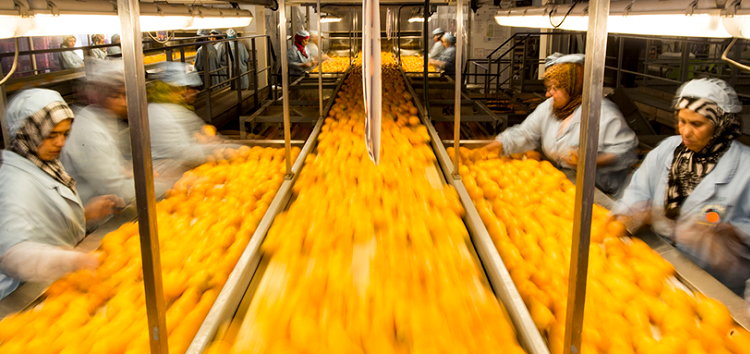New EBRD and FAO report shows pathways for decarbonising agrifood systems

A new report from the European Bank for Reconstruction and Development (EBRD) and the Food and Agriculture Organization of the United Nations (FAO) provides a comprehensive look at decarbonising agrifood systems, which is necessary and achievable.
The report, Investing in carbon neutrality: Utopia or the new green wave? Challenges and opportunities for agrifood systems, draws on insights from a wide range of stakeholders and sets out five areas for action to move the decarbonisation agenda forward.
The latest United Nations climate report reminds us that the clock is ticking to reduce emissions, curb global warming and address the climate crisis before it is too late. The world’s agrifood systems must do their part.
Agrifood system emissions account for 21-37 per cent of total anthropogenic greenhouse gas (GHG) emissions, depending on estimates. At the same time, climate change adversely affects agrifood system actors in different ways, from smallholder farmers to large food manufacturers. Rising temperatures, changing rainfall patterns and supply chain disruptions already impact food production, undermining global efforts to end hunger. As a result, the number of people facing hunger could reach one billion by 2050.
These vulnerabilities are a stark reminder of the need to transform these systems, says FAO Investment Centre Director Mohamed Manssouri: “We need to double down and mobilise greater investment, knowledge and innovations to make our agrifood systems greener, more resilient, more productive and more efficient at providing healthy and nutritious diets, good jobs and biodiversity.”
“Agriculture is both a cause and a victim of climate change, and it must be part of the climate solution,” he added, pointing to the potential to engage food and land-use systems to reduce emissions and act as a carbon sink. Only the economic mitigation potential of agricultural activities can be substantial: according to IPCC Fifth Assessment Report estimates it can reach around 4 GtCO2 eq yr-1 by 2030, which is equivalent to around 7 per cent of current total anthropogenic emissions. That could translate to potential economic benefits in the hundreds of billions of dollars.
Gianpiero Nacci, EBRD Director, Green Economy and Climate Action, said: “Decarbonising the agrifood sector is possible and not some utopian ideal or box-ticking exercise. There are low-carbon pathways, as we highlight in the report, but they call for strong political and corporate commitment, concerted action, including sound policies and good governance, and dedicated investment and human resources to see results.”
What can be done about it?
The report argues that the private sector has much to gain by decarbonising agrifood systems – including reducing costs, mitigating risks, protecting brand value, ensuring long-term supply chain viability, and gaining competitive advantages.
It also notes that some companies have committed to ambitious emissions reduction targets. But efforts have been uneven. For one, achieving carbon neutrality is still voluntary. Also, it can be significantly more expensive for a smaller company to become carbon neutral than for a larger one. And it can vary from sector to sector.
Consumers are often not willing to pay a premium for carbon-neutral products, which combined with a low implicit price of emitting means that not all carbon reduction approaches pay off for agrifood system actors. In addition, offsetting costs – at current carbon prices – can be much lower than reduction costs across emissions-intensive sectors.
The report identifies five action areas that show what different stakeholders – policymakers, agribusinesses, farmers, international organisations – can do to accelerate the transition to greener agrifood systems: (i) strategically target carbon neutrality, (ii) improve and standardise tools and methods, (iii) promote sound governance mechanisms, (iv) directly support companies and farmers to decarbonise, and (v) educate and communicate on carbon neutrality.
Governments can set the tone through policies, strategies and road maps, including a strong commitment to their Nationally Determined Contributions (NDCs). They can regulate carbon emissions or provide incentives for the adoption of low-carbon technologies, as well as support the development of transparent and efficient carbon markets. Measuring carbon neutrality can be a major challenge for private companies. Governments can help by defining, simplifying and harmonising internationally recognised standards for carbon accounting.The report notes that there is a strong need for better, more standardised tools and methods for collecting data and measuring, reporting and verifying emissions, and also for sound governance mechanisms to guide low-carbon investment and private-sector compliance. In particular, improved regulations and institutional solutions can lead to greater development of carbon markets, as well as creating more opportunities for green finance.
Concessional financing and incentives, as well as the development of carbon markets and green finance instruments can support companies and ultimately farmers to decarbonise their operations. Developing capacities and sharing knowledge at all levels, from farmers and companies to service providers and consumers, is also important. Simple, more transparent and reliable communication on a product’s environmental footprint can have an impact on consumers’ purchasing habits.
Moving the needle
In 2020 the EBRD adopted an ambitious Green Economy Transition approach, and as of 2021 it has financed more than 2,000 projects expected to reduce 100 million tonnes of carbon emissions annually. FAO is dedicated to helping countries achieve their sustainable development goals and to this end, FAO is supporting countries in advancing low-carbon value chain development.
The investment landscape is evolving; banks are aligning with net-zero emission objectives and asset managers are increasingly looking to decarbonise their portfolios while managing climate risks. This can have far-ranging implications from large multinationals up to the small-scale farm level.
In this context, the EBRD and FAO believe that a new green wave – via investment, research, commitment and action – can radically transform agrifood systems and move the needle towards a low-carbon future.

